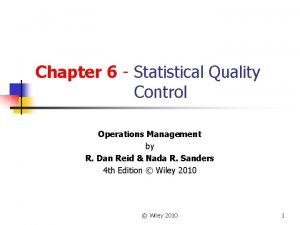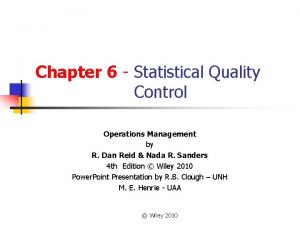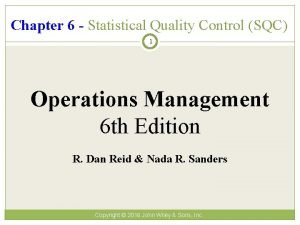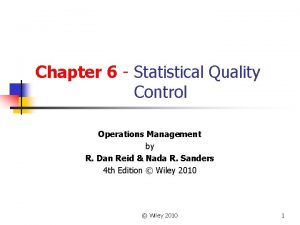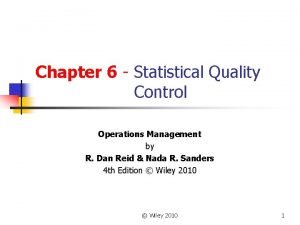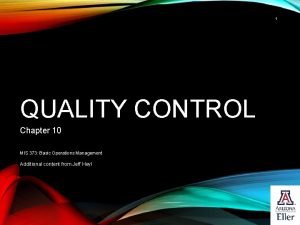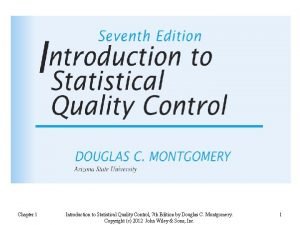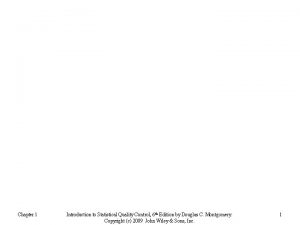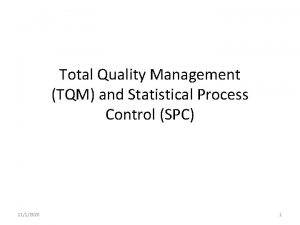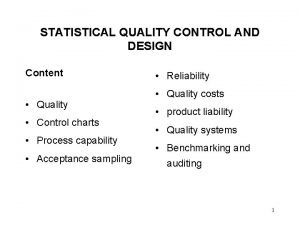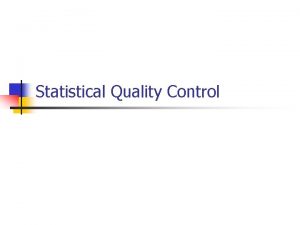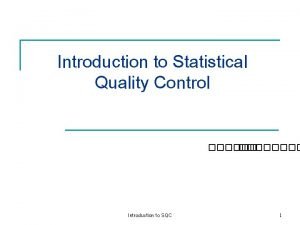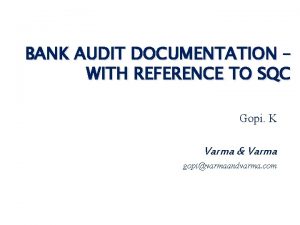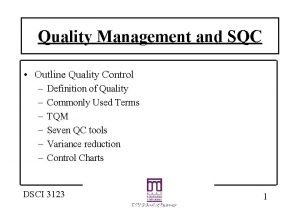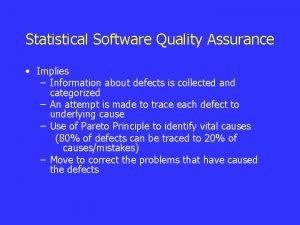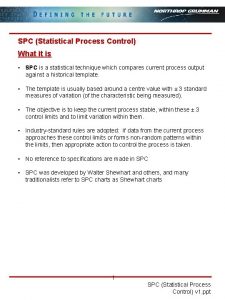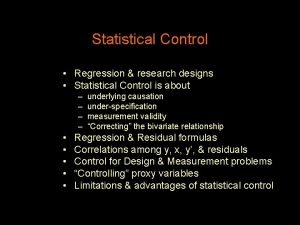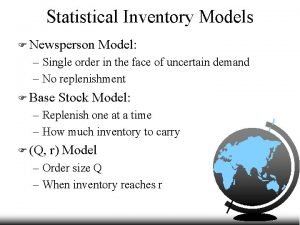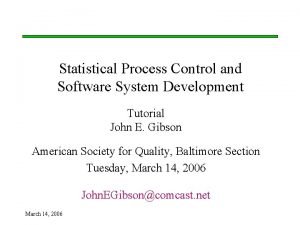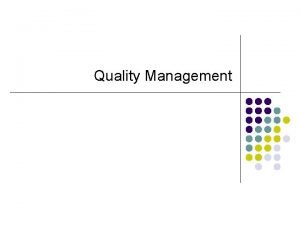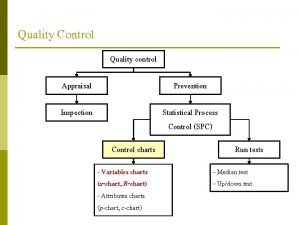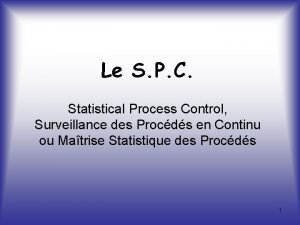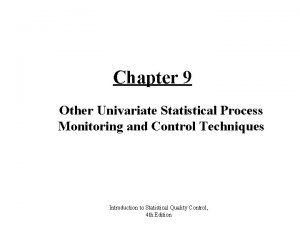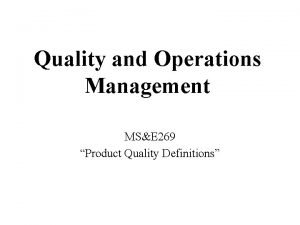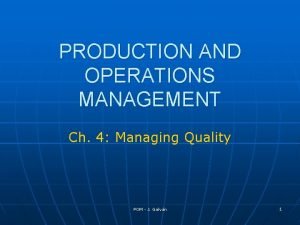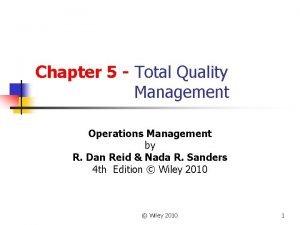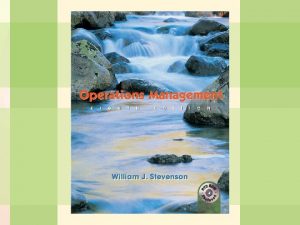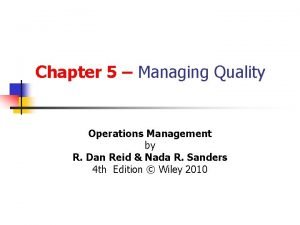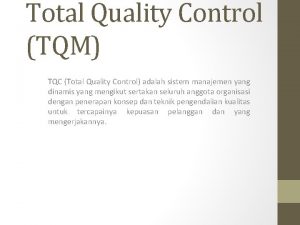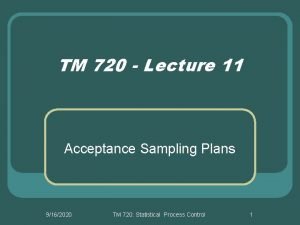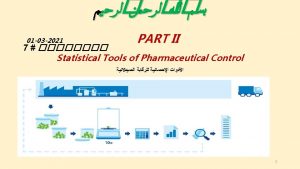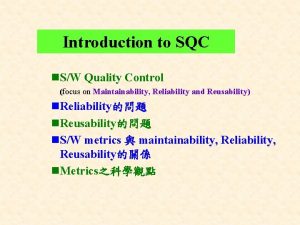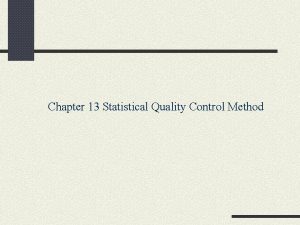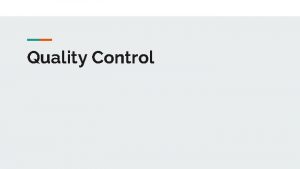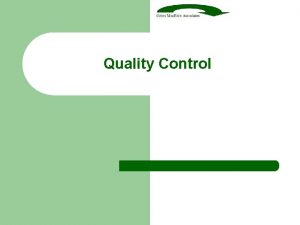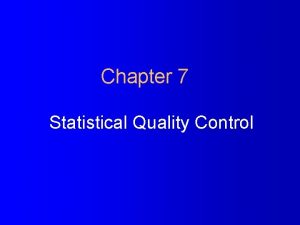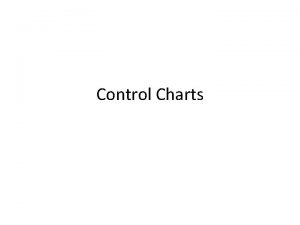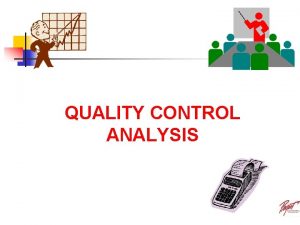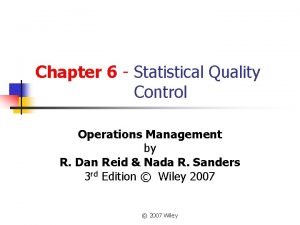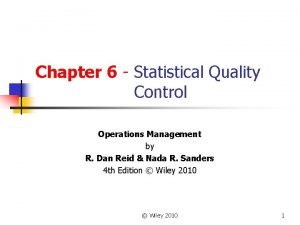Chapter 6 Statistical Quality Control SQC 1 Operations













































- Slides: 45

Chapter 6 - Statistical Quality Control (SQC) 1 Operations Management 6 th Edition R. Dan Reid & Nada R. Sanders Copyright © 2016 John Wiley & Sons, Inc.

Learning Objectives 2 Describe categories of statistical quality control (SQC). Identify and describe causes of variation. Explain the use of descriptive statistics in measuring quality characteristics. Describe the use of control charts. Identify the differences between x-bar and Rcharts. Copyright © 2016 John Wiley & Sons, Inc.

Learning Objectives - cont'd 3 Identify the differences between p- and c-charts. Explain the meaning of process capability and the process capability index. Explain the concept Six Sigma. Explain the process of acceptance sampling and describe the use of operating characteristic (OC) curves. Identify decisions that managers must make when implementing SPC. Describe the challenges inherent in measuring quality in service organizations. Copyright © 2016 John Wiley & Sons, Inc.

What is SQC? 4 Statistical Quality Control (SQC) the term used to describe the set of statistical tools used by quality professionals to evaluate organizational quality. Copyright © 2016 John Wiley & Sons, Inc.

3 Categories of SQC 5 1. Statistical process control (SPC) inspecting a random sample of an output from process, within range and functioning properly 2. 3. Descriptive statistics the mean, standard deviation, and range § Involve inspecting the output from a process § Quality characteristics are measured and charted § Helps identify in-process variations Acceptance sampling used to randomly inspect a batch of goods to determine acceptance/rejection § Does not help to catch in-process problems Copyright © 2016 John Wiley & Sons, Inc.

Sources of Variation 6 Variation exists in all processes. Variation can be categorized as either: Common or Random causes of variation, or Random causes that we cannot identify Unavoidable, i. e. ; slight differences in process variables like diameter, weight, service time, temperature Assignable causes of variation Causes can be identified Eliminate cause i. e. ; poor employee training, worn tool, machine needing repair Copyright © 2016 John Wiley & Sons, Inc.

Descriptive Statistics 7 The Mean- measure of central tendency The Range- difference between largest/smallest observations in a set of data Standard Deviation measures the amount of data dispersion around mean Distribution of Data shape Normal or bell shaped or Skewed Copyright © 2016 John Wiley & Sons, Inc.

Distribution of Data 8 Normal distributions Skewed distribution Copyright © 2016 John Wiley & Sons, Inc.

SPC Methods-Developing Control Charts 9 Control Charts (aka process or QC charts) show sample data plotted on a graph with CL, UCL, and LCL Control chart for variables are used to monitor characteristics that can be measured, e. g. length, weight, diameter, time Control charts for attributes are used to monitor characteristics that have discrete values and can be counted, e. g. % defective, # of flaws in a shirt, etc. Copyright © 2016 John Wiley & Sons, Inc.

Setting Control Limits 10 Copyright © 2016 John Wiley & Sons, Inc.

Control Charts for Variables 11 Use x-Bar and R-bar charts together Used to monitor different variables x-Bar and R-bar charts reveal different problems What is the statistical control difference from one chart to the next? Copyright © 2016 John Wiley & Sons, Inc.

Control Charts for Variables 12 Use x-Bar charts to monitor the changes in the mean of a process (central tendencies) Use R-bar charts to monitor the dispersion or variability of the process System can show acceptable central tendencies but unacceptable variability System can show acceptable variability but unacceptable central tendencies Copyright © 2016 John Wiley & Sons, Inc.

Constructing an x-Bar Chart: A quality control inspector at the Cocoa Fizz soft drink company has taken three samples with four observations each of the volume of bottles filled. If the standard deviation of the bottling operation is. 2 ounces, use the below data to develop control charts with limits of 3 standard deviations for the 16 oz. bottling operation. 13 Time 1 Time 2 Time 3 Observation 1 15. 8 16. 1 16. 0 Observation 2 16. 0 15. 9 Observation 3 15. 8 15. 9 Observation 4 15. 9 15. 8 Sample means (Xbar) 15. 875 15. 9 Sample ranges (R) 0. 2 0. 3 0. 2 Center line and control limit formulas Copyright © 2016 John Wiley & Sons, Inc.

Solution and x-Bar Control Chart 14 Center line (x-double bar): Control limits for± 3σ limits:

x-Bar Control Chart 15 Copyright © 2016 John Wiley & Sons, Inc.

Control Chart for Range (R) 16 Center Line and Control Limit formulas: Factors for three sigma control limits Sample Size (n) Factor for x-Chart 2 3 4 5 6 7 8 9 10 11 12 13 14 15 Copyright © 2016 John Wiley & Sons, Inc. A 2 1. 88 1. 02 0. 73 0. 58 0. 42 0. 37 0. 34 0. 31 0. 29 0. 27 0. 25 0. 24 0. 22 Factors for R-Chart D 3 0. 00 0. 08 0. 14 0. 18 0. 22 0. 26 0. 28 0. 31 0. 33 0. 35 D 4 3. 27 2. 57 2. 28 2. 11 2. 00 1. 92 1. 86 1. 82 1. 78 1. 74 1. 72 1. 69 1. 67 1. 65

R-Bar Control Chart 17 Copyright © 2016 John Wiley & Sons, Inc.

Second Method for the x-Bar Chart Using R-bar & A 2 Factor 18 Use this method, Control limits solution, when sigma for the process distribution is not known: Copyright © 2016 John Wiley & Sons, Inc.

Control Charts for Attributes–P-Charts & C-Charts 19 Attributes are discrete events: yes/no or pass/fail Use P-Charts for quality characteristics that are discrete and involve yes/no or good/bad decisions Number of leaking caulking tubes in a box of 48 Number of broken eggs in a carton Use C-Charts for discrete defects when there can be more than one defect per unit Number of flaws or stains in a carpet sample cut from a production run Number of complaints per customer at a hotel Copyright © 2016 John Wiley & Sons, Inc.

P-Chart Example: A production manager for a tire company has inspected the number of defective tires in five random samples with 20 tires in each sample. The table below shows the number of defective tires in each sample of 20 tires. 20 Calculate the control limits. Sample Number of Defective Tires Number of Tires in each Sample Proportion Defective 1 3 20 . 15 2 2 20 . 10 3 1 20 . 05 4 2 20 . 10 5 1 20 . 05 Total 9 100 . 09 Solution: P-Charts are used when both the total sample size and the number of defects can be computed

P- Control Chart 21 Copyright © 2016 John Wiley & Sons, Inc.

C-Chart Example: The number of weekly customer complaints are monitored in a large hotel using a c-chart. Develop three sigma control limits using the data table below. 22 Week Number of Complaints 1 3 2 2 3 3 4 1 5 3 6 3 7 2 8 1 9 3 10 1 Total 22 Solution: C-Charts are used when you can compute only the number of defects but not the proportion that is defective

C- Control Chart 23 Copyright © 2016 John Wiley & Sons, Inc.

Process Capability 24 Product Specifications Preset product or service dimensions, tolerances: bottle fill might be 16 oz. ±. 2 oz. (15. 8 oz. -16. 2 oz. ) Based on how product is to be used or what the customer expects

Process Capability - cont’d 25 Process Capability – Cp and Cpk Assessing capability involves evaluating process variability relative to preset product or service specifications Cp assumes that the process is centered in the specification range Cpk helps to address a possible lack of centering of the process

Relationship Between Process Variability & Specification Width 26 Three possible ranges for Cp = 1, as in Fig. (a), process variability just meets specifications Cp ≤ 1, as in Fig. (b), process not capable of producing within specifications Cp ≥ 1, as in Fig. (c), process exceeds minimal specifications One shortcoming, Cp assumes that the process is centered on the specification range Cp=Cpk when process is centered

Relationship Between Process Variability & Specification Width 27

Computing the Cp Value at Cocoa Fizz: 3 bottling machines are being evaluated for possible use at the Fizz plant. The machines must be capable of meeting the design specification of 15. 8 -16. 2 oz. with at least a process capability index of 1. 0 (Cp≥ 1) 28 The table below shows the information gathered from production runs on each machine. Are they all acceptable? Machine σ USL-LSL Solution: Machine A 6σ A . 05 . 4 . 3 B . 1 . 4 . 6 C . 2 . 4 1. 2 Machine B Cp= Machine C Cp= Copyright © 2016 John Wiley & Sons, Inc.

Computing the Cpk Value at Cocoa Fizz 29 Design specifications call for a target value of 16. 0 ± 0. 2 OZ. (USL = 16. 2 & LSL = 15. 8) Observed process output has now shifted and has a µ of 15. 9 and a σ of 0. 1 oz. Cpk is less than 1, revealing that the process is not capable

± 6 Sigma versus ± 3 Sigma 30 In 1980’s, Motorola coined “six- sigma” to describe their higher quality efforts Six-sigma quality standard is now a benchmark in many industries PPM Defective for ± 3σ versus ± 6σ quality Before design, marketing ensures customer product characteristics Operations ensures that product design characteristics can be met by controlling materials and processes to 6σ levels Other functions like finance and accounting use 6σ concepts to control all of their processes Copyright © 2016 John Wiley & Sons, Inc.

Acceptance Sampling 31 Defined: the third branch of SQC refers to the process of randomly inspecting a certain number of items from a lot or batch in order to decide whether to accept or reject the entire batch Different from SPC because acceptance sampling is performed either before or after the process rather than during Sampling before typically is done to supplier material Sampling after involves sampling finished items before shipment or finished components prior to assembly Used where inspection is expensive, volume is high, or inspection is destructive Copyright © 2016 John Wiley & Sons, Inc.

Acceptance Sampling Plans 32 Goal of Acceptance Sampling plans is to determine the criteria for acceptance or rejection based on: Size of the lot (N) Size of the sample (n) Number of defects above which a lot will be rejected (c) Level of confidence we wish to attain There are single, double, and multiple sampling plans Which one to use is based on cost involved, time consumed, and cost of passing on a defective item Can be used on either variable or attribute measures, but more commonly used for attributes Copyright © 2016 John Wiley & Sons, Inc.

Operating Characteristics (OC) Curves 33 OC curves are graphs which show the probability of accepting a lot given various proportions of defects in the lot X-axis shows % of items that are defective in a lot- “lot quality” Y-axis shows the probability or chance of accepting a lot As proportion of defects increases, the chance of accepting lot decreases Example: 90% chance of accepting a lot with 5% defectives; 10% chance of accepting a lot with 24% defectives Copyright © 2016 John Wiley & Sons, Inc.

AQL, LTPD, Consumer’s Risk (α) & Producer’s Risk (β) 34 AQL is the small % of defects that consumers are willing to accept; order of 1 -2% LTPD is the upper limit of the percentage of defective items consumers are willing to tolerate Consumer’s Risk (β) is the chance of accepting a lot that contains a greater number of defects than the LTPD limit; Type II error Producer’s Risk (α) is the chance a lot containing an acceptable quality level will be rejected; Type I error Copyright © 2016 John Wiley & Sons, Inc.

Developing OC Curves 35 OC curves graphically depict discriminating power of a sampling plan Cumulative binomial tables like partial table below are used to obtain probabilities of accepting a lot given varying levels of lot defectives Top of the table shows value of p (proportion of defective items in lot), Left hand column shows values of n (sample size) and x represents the cumulative number of defects found Table 6 -2 Partial Cumulative Binomial Probability Table (see Appendix C for complete table) Proportion of Items Defective (p) . 05 . 10 . 15 . 20 . 25 . 30 . 35 . 40 . 45 . 50 n x 5 0 . 7738. 5905. 4437. 3277. 2373. 1681. 1160. 0778. 0503. 0313 Pac 1 . 9974. 9185. 8352. 7373. 6328. 5282. 4284. 3370. 2562. 1875 AOQ . 0499. 0919. 1253. 1475. 1582. 1585. 1499. 1348. 1153. 0938 Copyright © 2016 John Wiley & Sons, Inc.

Example: Constructing an OC Curve 36 Lets develop an OC curve for a sampling plan in which a sample of 5 items is drawn from lots of N=1000 items The accept /reject criteria are set up in such a way that we accept a lot if no more that one defect (c=1) is found Using Table 6 -2 and the row corresponding to n=5 and x=1 Note that we have a 99. 74% chance of accepting a lot with 5% defects and a 73. 73% chance with 20% defects Copyright © 2016 John Wiley & Sons, Inc.

Average Outgoing Quality (AOQ) 37 With OC curves, the higher the quality of the lot, the higher is the chance that it will be accepted Conversely, the lower the quality of the lot, the greater is the chance that it will be rejected The average outgoing quality level of the product (AOQ) can be computed as follows: AOQ=(Pac)p Returning to the bottom line in Table 6 -2, AOQ can be calculated for each proportion of defects in a lot by using the above equation This graph is for n=5 and x=1 (same as c=1) AOQ is highest for lots close to 30% defects Copyright © 2016 John Wiley & Sons, Inc.

Implications for Managers 38 How much and how often to inspect? Consider product cost and product volume Consider process stability Consider lot size Where to inspect? Inbound materials Finished products Prior to costly processing Which tools to use? Control charts are best used for in-process production Acceptance sampling is best used for inbound/outbound; attribute measures Control charts are easier to use for variable measures Copyright © 2016 John Wiley & Sons, Inc.

SQC in Services 39 Service Organizations have lagged behind manufacturers in the use of statistical quality control Statistical measurements are required and it is more difficult to measure the quality of a service Services produce more intangible products Perceptions of quality are highly subjective A way to deal with service quality is to devise quantifiable measurements of the service element Check-in time at a hotel Number of complaints received per month at a restaurant Number of telephone rings before a call is answered Acceptable control limits can be developed and charted Copyright © 2016 John Wiley & Sons, Inc.

Service at a bank: The Dollars Bank competes on customer service and is concerned about service time at their drive-by windows. They recently installed new system software which they hope will meet service specification limits of 5± 2 minutes and have a Capability Index (Cpk) of at least 1. 2. They want to also design a control chart for bank teller use. 40 They have done some sampling recently (sample size: 4 customers) and determined that the process mean has shifted to 5. 2 with a Sigma of 1. 0 minutes. Control Chart limits for ± 3 sigma limits

SQC Across the Organization 41 SQC requires input from other organizational functions, influences their success, and used in designing and evaluating their tasks Marketing – provides information on current and future quality standards Finance – responsible for placing financial values on SQC efforts Human resources – the role of workers change with SQC implementation. Requires workers with right skills Information systems – makes SQC information accessible for all. Copyright © 2016 John Wiley & Sons, Inc.

Chapter 6 Highlights 42 SQC refers to statistical tools that can be sued by quality professionals. SQC an be divided into three categories: traditional statistical tools, acceptance sampling, and statistical process control (SPC). Descriptive statistics are used to describe quality characteristics, such as the mean, range, and variance. Acceptance sampling is the process of randomly inspecting a sample of goods and deciding whether to accept or reject the entire lot. Statistical process control involves inspecting a random sample of output from a process and deciding whether the process in producing products with characteristics that fall within preset specifications. Copyright © 2016 John Wiley & Sons, Inc.

Chapter 6 Highlights – cont'd 43 Two causes of variation in the quality of a product or process: common causes and assignable causes. Common causes of variation are random causes that we cannot identify. Assignable causes of variation are those that can be identified and eliminated. A control chart is a graph used in SPC that shows whether a sample of data falls within the normal range of variation. A control chart has upper and lower control limits that separate common from assignable causes of variation. Control charts for variables monitor characteristics that can be measured and have a continuum of values, such as height, weight, or volume. Control charts for attributes are used to monitor characteristics that have discrete values and can be counted. Copyright © 2016 John Wiley & Sons, Inc.

Chapter 6 Highlights – cont'd 44 Control charts for variables include x-Bar and R-charts. X-bar charts monitor the mean or average value of a product characteristic. R-charts monitor the range or dispersion of the values of a product characteristic. Control charts for attributes include p-charts and c-charts. P-charts are used to monitor the proportion of defects in a sample, C-charts are used to monitor the actual number of defects in a sample. Process capability is the ability of the production process to meet or exceed preset specifications. It is measured by the process capability index Cp which is computed as the ratio of the specification width to the width of the process variable. Copyright © 2016 John Wiley & Sons, Inc.

Chapter 6 Highlights – cont'd 45 The term Six Sigma indicates a level of quality in which the number of defects is no more than 2. 3 parts per million. The goal of acceptance sampling is to determine criteria for the desired level of confidence. Operating characteristic curves are graphs that show the discriminating power of a sampling plan. It is more difficult to measure quality in services than in manufacturing. The key is to devise quantifiable measurements for important service dimensions. Copyright © 2016 John Wiley & Sons, Inc.
 Sqc of filling processes
Sqc of filling processes Statistical quality control in operations management
Statistical quality control in operations management Sqc in operations management
Sqc in operations management What is sqc in operations management
What is sqc in operations management Sqc in operations management
Sqc in operations management Operations management chapter 10 quality control solutions
Operations management chapter 10 quality control solutions Introduction to statistical quality control montgomery
Introduction to statistical quality control montgomery Introduction to statistical quality control
Introduction to statistical quality control Grandfather of tqm
Grandfather of tqm Content quality control
Content quality control Perform quality assurance
Perform quality assurance Pmp quality management
Pmp quality management Pmbok quality management
Pmbok quality management Concepts of quality
Concepts of quality Sqc table
Sqc table Sqc meaning
Sqc meaning Sqc in banking
Sqc in banking Sqc definition
Sqc definition Statistical quality assurance in software engineering
Statistical quality assurance in software engineering Statistical software quality assurance
Statistical software quality assurance Statistical process control ppt
Statistical process control ppt Statistical control in research
Statistical control in research Statistical inventory control
Statistical inventory control Statistical process control tutorial
Statistical process control tutorial Mssc introduction to spc
Mssc introduction to spc Statistical process control
Statistical process control Inspection chart
Inspection chart Statistical process control definition
Statistical process control definition Statistical process control
Statistical process control Cwqc ishikawa
Cwqc ishikawa Managing quality in operations management
Managing quality in operations management Operations and quality management
Operations and quality management House of quality operations management
House of quality operations management Quality operations management
Quality operations management Chapter 6 managing quality
Chapter 6 managing quality Foqa advisory circular
Foqa advisory circular Managing quality in operations management
Managing quality in operations management What is tqm
What is tqm Define quality assurance in nursing
Define quality assurance in nursing Compliance vs quality
Compliance vs quality Two quality gurus
Two quality gurus Crosby's fourteen steps to quality improvement
Crosby's fourteen steps to quality improvement What is tqm
What is tqm Mémoire inspe
Mémoire inspe Contoh tqc
Contoh tqc Acceptance sampling procedure
Acceptance sampling procedure
